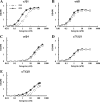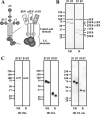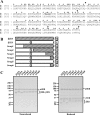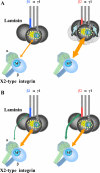The C-terminal region of laminin beta chains modulates the integrin binding affinities of laminins
- PMID: 19147489
- PMCID: PMC2658076
- DOI: 10.1074/jbc.M809332200
The C-terminal region of laminin beta chains modulates the integrin binding affinities of laminins
Abstract
Laminins are major cell-adhesive proteins in basement membranes that are capable of binding to integrins. Laminins consist of three chains (alpha, beta, and gamma), in which three laminin globular modules in the alpha chain and the Glu residue in the C-terminal tail of the gamma chain have been shown to be prerequisites for binding to integrins. However, it remains unknown whether any part of the beta chain is involved in laminin-integrin interactions. We compared the binding affinities of pairs of laminin isoforms containing the beta1 or beta2 chain toward a panel of laminin-binding integrins, and we found that beta2 chain-containing laminins (beta2-laminins) bound more avidly to alpha3beta1 and alpha7X2beta1 integrins than beta1 chain-containing laminins (beta1-laminins), whereas alpha6beta1, alpha6beta4, and alpha7X1beta1 integrins did not show any preference toward beta2-laminins. Because alpha3beta1 contains the "X2-type" variable region in the alpha3 subunit and alpha6beta1 and alpha6beta4 contain the "X1-type" region in the alpha6 subunit, we hypothesized that only integrins containing the X2-type region were capable of discriminating between beta1-laminins and beta2-laminins. In support of this possibility, a putative X2-type variant of alpha6beta1 was produced and found to bind preferentially to beta2-laminins. Production of a series of swap mutants between the beta1 and beta2 chains revealed that the C-terminal 20 amino acids in the coiled-coil domain were responsible for the enhanced integrin binding by beta2-laminins. Taken together, the results provide evidence that the C-terminal region of beta chains is involved in laminin recognition by integrins and modulates the binding affinities of laminins toward X2-type integrins.
Figures









Similar articles
-
Ligand-binding specificities of laminin-binding integrins: a comprehensive survey of laminin-integrin interactions using recombinant alpha3beta1, alpha6beta1, alpha7beta1 and alpha6beta4 integrins.Matrix Biol. 2006 Apr;25(3):189-97. doi: 10.1016/j.matbio.2005.12.001. Epub 2006 Jan 18. Matrix Biol. 2006. PMID: 16413178
-
The requirement of the glutamic acid residue at the third position from the carboxyl termini of the laminin gamma chains in integrin binding by laminins.J Biol Chem. 2007 Apr 13;282(15):11144-54. doi: 10.1074/jbc.M609402200. Epub 2007 Feb 15. J Biol Chem. 2007. PMID: 17307733
-
Screening of integrin-binding peptides in a laminin peptide library derived from the mouse laminin β chain short arm regions.Arch Biochem Biophys. 2014 May 15;550-551:33-41. doi: 10.1016/j.abb.2014.04.008. Epub 2014 Apr 28. Arch Biochem Biophys. 2014. PMID: 24785228
-
Molecular Basis of Laminin-Integrin Interactions.Curr Top Membr. 2015;76:197-229. doi: 10.1016/bs.ctm.2015.07.002. Epub 2015 Aug 10. Curr Top Membr. 2015. PMID: 26610915 Review.
-
Structural biology of laminins.Essays Biochem. 2019 Sep 13;63(3):285-295. doi: 10.1042/EBC20180075. Print 2019 Sep 13. Essays Biochem. 2019. PMID: 31092689 Free PMC article. Review.
Cited by
-
Crystal structure of the LG1-3 region of the laminin alpha2 chain.J Biol Chem. 2009 Aug 21;284(34):22786-92. doi: 10.1074/jbc.M109.026658. Epub 2009 Jun 24. J Biol Chem. 2009. PMID: 19553699 Free PMC article.
-
Laminin fragments conjugated with perlecan's growth factor-binding domain differentiate human induced pluripotent stem cells into skin-derived precursor cells.Sci Rep. 2023 Sep 4;13(1):14556. doi: 10.1038/s41598-023-41701-5. Sci Rep. 2023. PMID: 37666868 Free PMC article.
-
A novel laminin β gene BmLanB1-w regulates wing-specific cell adhesion in silkworm, Bombyx mori.Sci Rep. 2015 Jul 27;5:12562. doi: 10.1038/srep12562. Sci Rep. 2015. PMID: 26212529 Free PMC article.
-
Laminin-221 Enhances Therapeutic Effects of Human-Induced Pluripotent Stem Cell-Derived 3-Dimensional Engineered Cardiac Tissue Transplantation in a Rat Ischemic Cardiomyopathy Model.J Am Heart Assoc. 2020 Aug 18;9(16):e015841. doi: 10.1161/JAHA.119.015841. Epub 2020 Aug 12. J Am Heart Assoc. 2020. PMID: 32783519 Free PMC article.
-
Basement membranes: cell scaffoldings and signaling platforms.Cold Spring Harb Perspect Biol. 2011 Feb 1;3(2):a004911. doi: 10.1101/cshperspect.a004911. Cold Spring Harb Perspect Biol. 2011. PMID: 21421915 Free PMC article. Review.
References
Publication types
MeSH terms
Substances
LinkOut - more resources
Full Text Sources
Other Literature Sources

